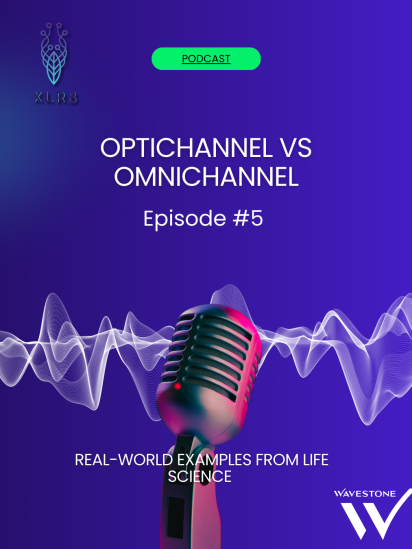How is optichannel redefining customer engagement in Pharma?
Published September 18, 2025
- Customer Experience
- Life Sciences

Key takeaways
- Optichannel, builds on the foundations of omnichannel, and cuts through the noise: it uses data to target the right HCPs, on the right channels, at the right time, driving real engagement and faster results.
- Successfully implementing optichannel in your organization requires aligning teams, defining and tracking metrics, and practicing smart channel management
- An industry expert discusses a real life example of how she implemented optichannel in her organization – tune in to our podcast
Pharma continues to lag behind sectors like finance and retail in delivering seamless omnichannel experiences, even as customer expectations rise. Digital campaigns often get stuck in slow approval cycles and generic messaging, leaving healthcare professionals (HCPs) disengaged. Even the best omnichannel strategies can fall short when they prioritize presence over precision…
Understanding the shift: omnichannel vs. optichannel
Omnichannel strategies aim to deliver a seamless experience across all available channels. While effective in theory, this approach can be resource-intensive and often lacks the nuance needed to truly resonate with HCPs.
Optichannel refines this model. Instead of being everywhere, it focuses on being where it matters most, delivering the right message, through the right channel, at the right time, based on actionable customer insights. It’s not about doing more; it’s about doing better.
By analyzing engagement data and behavioral patterns, optichannel strategies help pharma teams:
- Prioritize high-impact channels
- Personalize communications
- Optimize budgets and resources
Why is optichannel gaining ground?
Optichannel is gaining traction because it blends technology, data, and customer insight to create more meaningful interactions. For pharmaceutical companies, this means:
- Improved engagement through tailored, relevant content
- Streamlined operations by focusing on effective channels
- Enhanced compliance without compromising agility
While omnichannel aims to provide a consistent experience across all channels, optichannel focuses on optimizing the customer experience by using the most effective channels. The best approach depends on your specific business goals.
3 keys to success
Implementing optichannel is as much about people as it is about platforms. Success requires alignment across marketing, sales, medical, compliance, and business intelligence teams—each with distinct goals and concerns.
Treat internal stakeholders like external customers:
- Engage them early
- Tailor messaging to their priorities
- Demonstrate value through early wins
For example, marketing may see improved engagement metrics, while compliance teams benefit from streamlined workflows and clearer visibility into customer needs.
Measurement is essential. Success should be tracked across three dimensions:
- Performance: engagement rates, click-throughs, bounce rates
- Operational efficiency: faster approval cycles, reduced redundancies, quicker campaign execution
- Strategic outcomes: long-term shifts in brand perception, customer loyalty, and improved patient care
Regularly communicate progress in ways that resonate with each internal team to maintain momentum and alignment.
Optichannel doesn’t mean abandoning channels, it means strategic prioritization. Some channels may be scaled back for certain segments, while others receive increased investment based on proven engagement.
Maintain a baseline presence across all touchpoints and concentrate resources where they deliver the most value.
Navigating internal and external challenges
Resistance to change is natural. Teams may be comfortable with existing processes and view new strategies as disruptive. To overcome this:
- Secure strong leadership advocacy
- Foster cross-functional collaboration
- Embrace agile, customer-centric operational models
Pharma companies also face external hurdles, including:
- Data privacy regulations (e.g., GDPR) that limit data collection and personalization
- E-consent fatigue among HCPs, who receive multiple requests from various companies
- Channel saturation, making it harder to stand out
- Varying digital literacy among HCPs, requiring flexible channel strategies
- Technology limitations, such as outdated infrastructure or disconnected systems
Success requires a holistic approach, addressing both internal readiness and external realities to unlock the full potential of optichannel engagement .
Conclusion
The future is optichannel

Optichannel isn’t just a buzzword, it’s a blueprint for the future of pharma engagement. By aligning strategy, technology, and culture, companies can build deeper relationships with HCPs, drive better outcomes, and ultimately improve patient care.
Is your organization ready to make the shift?
To hear how one organization is embracing optichannel, tune in to our recent podcast with Olena Shchepina, European Digital Transformation Lead at Viatris and discover how they are harnessing optichannel to deliver value.

